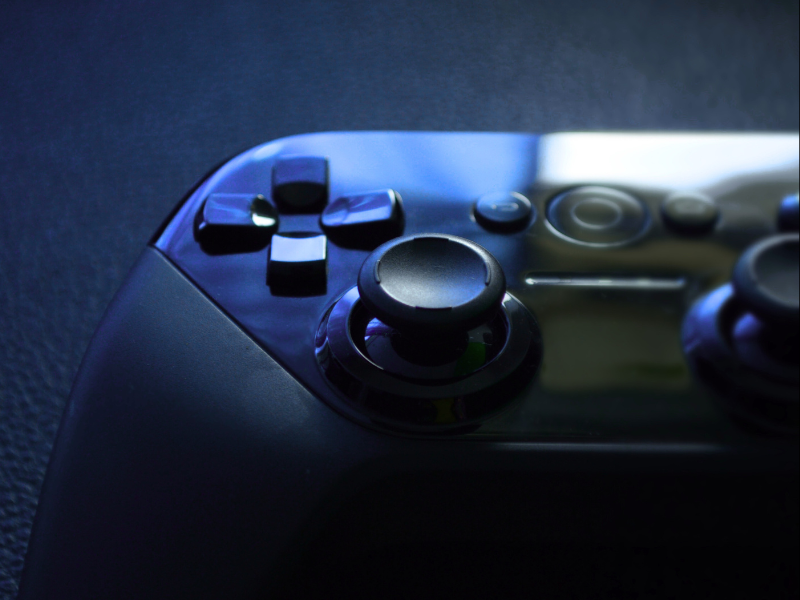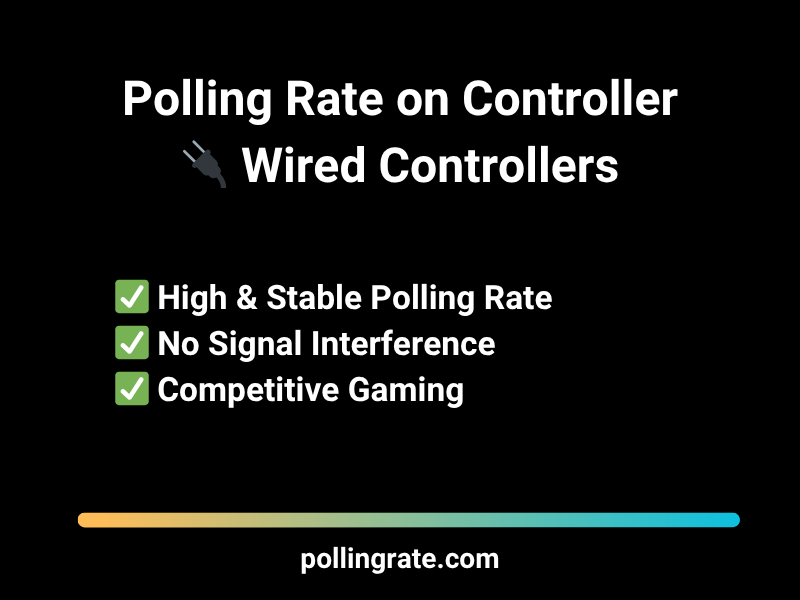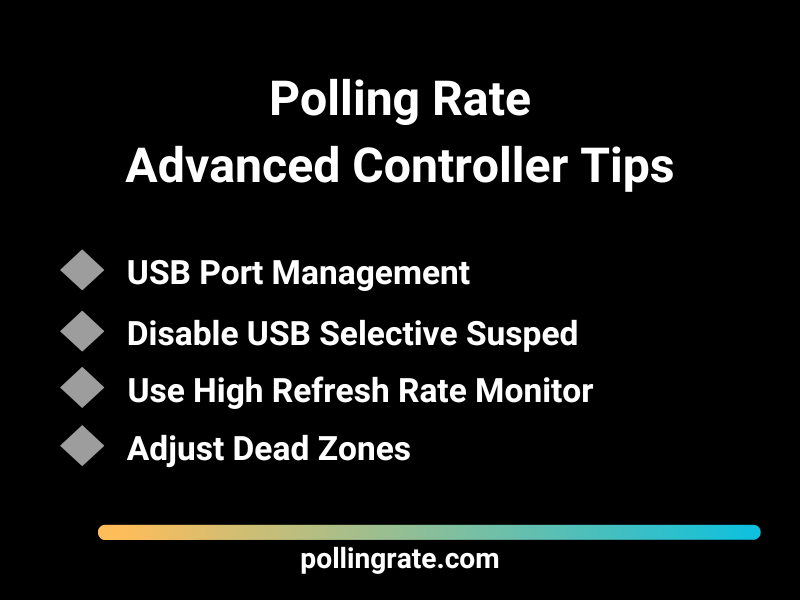Polling Rate on Controller: The Ultimate Pro Gamer’s Deep Dive
Polling rate controller is a critical technical specification that dictates how often the controller transmits input data—button presses, trigger positions, analog stick movements—to your console or PC. Measured in Hertz (Hz), it represents the number of updates per second: a 500 Hz polling rate means the controller updates the system every 2 milliseconds, while a 1000 Hz polling rate reduces this interval to just 1 millisecond.
While casual gamers may not perceive the nuances of polling rate, competitive players, speedrunners, and eSports athletes rely on pinpoint accuracy and minimal input lag. A higher polling rate ensures that your every move—be it a twitch aim, a frame-perfect combo, or an exact drift—registers almost instantaneously.
Tip: Want to dominate the competition? Discover our #1 pick for serious gamers! on Amazon* (Affiliate Link)!

Why Polling Rate Matters for Competitive Gaming
In high-stakes environments, even microseconds can change the outcome of a match. Here’s why polling rate on a controller is so vital:
Ultra-Low Input Latency: Faster polling translates to reduced lag between your physical action and the in-game response.
Precise Analog Control: Racing sims, flight sims, and precise strafing in shooters benefit from smooth, consistent analog readings.
Flawless Combo Execution: Fighting games demand exact timing; a delayed punch or kick can break a combo chain.
Reliability Under Stress: During rapid-fire sequences, a high polling rate minimizes missed or dropped inputs.
Edge in Speedruns: When shaving milliseconds off your PB, consistent input timing becomes crucial.
This specification complements other performance factors—display refresh rate, frame rate, and USB polling on mice/keyboards—to create a seamless input pipeline.

Evolution of Controller Polling Protocols
Historical Context: Early gaming controllers (1990s era) communicated via simple serial protocols at <50 Hz. With the advent of USB in the early 2000s, polling rates standardized at 125 Hz (8ms interval). As competitive gaming grew, third-party manufacturers began offering overclocked controllers at 500 Hz and 1000 Hz.
| Era / Protocol | Typical Polling Rate | Notes |
|---|---|---|
| Parallel Port / Serial | 0–50 Hz | Early PC joysticks |
| USB 1.1 (Standard) | 125 Hz | Default for many console controllers via USB adapters |
| USB 2.0 Enhanced | 250 Hz | Introduced with PC USB 2.0, smoother polling possible |
| USB Overclocking Tools | 500 Hz – 1000 Hz | Enabled by utilities like HIDUSBF |
| Wireless (Bluetooth) | 30–125 Hz | Limited by Bluetooth bandwidth |
Parallel Port / Serial
Typical Polling Rate: 0–50 Hz
Early PC joysticksUSB 1.1 (Standard)
Typical Polling Rate: 125 Hz
Default for many console controllers via USB adaptersUSB 2.0 Enhanced
Typical Polling Rate: 250 Hz
Introduced with PC USB 2.0, smoother polling possibleUSB Overclocking Tools
Typical Polling Rate: 500 Hz – 1000 Hz
Enabled by utilities like HIDUSBFWireless (Bluetooth)
Typical Polling Rate: 30–125 Hz
Limited by Bluetooth bandwidthThird-party firmware hacks and pro-grade controllers now routinely push up to 1000 Hz in wired mode.
Standard vs. Pro-Grade Controllers: Polling Rate Breakdown
| Controller Class | Polling Rate | Connection | Typical Use Case |
|---|---|---|---|
| First-Party Wireless (Xbox/PS) | 60–125 Hz | Bluetooth | Casual and console play |
| Official Wired USB Adapters | 125–250 Hz | USB 2.0 | Console-to-PC adapters |
| Pro Controllers (SCUF, Victrix) | 500–1000 Hz | Wired USB 3 | eSports and tournament use |
| Tournament Arcade Sticks | 500–1000 Hz | Wired USB 2/3 | Fighting game tournaments |
| Custom Modded Controllers | Up to 1000 Hz | USB / Custom | Speedrunning and competitive mods |
First-Party Wireless (Xbox/PS)
Polling Rate: 60–125 Hz
Connection: Bluetooth
Typical Use Case: Casual and console playOfficial Wired USB Adapters
Polling Rate: 125–250 Hz
Connection: USB 2.0
Typical Use Case: Console-to-PC adaptersPro Controllers (SCUF, Victrix)
Polling Rate: 500–1000 Hz
Connection: Wired USB 3
Typical Use Case: eSports and tournament useTournament Arcade Sticks
Polling Rate: 500–1000 Hz
Connection: Wired USB 2/3
Typical Use Case: Fighting game tournamentsCustom Modded Controllers
Polling Rate: Up to 1000 Hz
Connection: USB / Custom
Typical Use Case: Speedrunning and competitive modsFor players seeking maximum performance, pro-grade solutions with 1000 Hz polling are the industry standard.
🎮 Polling Rate on Controller: Wired vs. Wireless – What Gamers Need to Know
When choosing between wired and wireless controllers, performance is more than just preference — it’s about input speed, reliability, und insbesondere die polling rate on controller. The way your controller communicates with your system can drastically impact gameplay responsiveness, especially in competitive scenarios.
🔌 Wired Controllers: Precision and Stability
Wired controllers are the top choice for gamers who value consistency and minimal input latency. Here’s why:
✅ High & Stable Polling Rate:
Wired gamepads can achieve 500 Hz to 1000 Hz, meaning the controller sends input signals to your system 500–1000 times per second — translating to ultra-low response times (1–2 ms).✅ No Signal Interference:
No risk of Bluetooth or RF (radio frequency) dropouts or latency spikes due to Wi-Fi congestion.✅ Ideal For:
Competitive PC gaming
Fighting games (e.g., Street Fighter, Tekken)
Speedrunning
LAN tournaments and esports
📌 Pro Tip: Many pro players opt for wired controllers not just for performance — but for tournament regulation compliance.

📡 Wireless Controllers: Comfort with Compromise
Wireless controllers offer convenience and freedom, but they do so with technical trade-offs — particularly around polling rate on controller:
⚠️ Lower Polling Rates:
Most wireless controllers operate at 30 Hz to 125 Hz, introducing input delays of 8–33 ms. While fine for casual play, this delay can impact fast-paced or reaction-based games.⚠️ Interference Risks:
Wireless signals can be disrupted by:Nearby Wi-Fi routers
Other Bluetooth devices
Crowded 2.4 GHz environments
🎮 Ideal For:
Couch co-op
Single-player RPGs or platformers
Casual and family gaming
💡 Pro Tip: Use Wired Mode When It Counts
Most modern wireless controllers (e.g., Xbox Wireless Controller, DualSense, 8BitDo) feature a wired fallback mode. When plugged in via USB-C or micro-USB, they often switch to higher polling rate on controller automatically.
✅ Use wired mode when:
Competing online
Practicing combos or frame-perfect moves
Streaming gameplay with input overlays
🔧 How to Change Polling Rate on Controller: Advanced Options for Power Users
While mice often come with built-in tools to customize polling rate, most gamepads lack direct support for tweaking the polling rate on controller. Still, advanced users on PC and certain high-end controllers can unlock faster response times through some lesser-known techniques.
1️⃣ USB Polling Overclocking (PC Only)
One of the most effective ways to increase the polling rate on controller is through USB overclocking — a method that pushes your gamepad’s communication frequency beyond factory limits.
✅ Tools You’ll Need:
HIDUSBF: A well-known driver patching tool
USB Overclocking Driver: Allows polling rate on controller to be adjusted at the driver level
🛠️ Step-by-Step Overview:
Install HIDUSBF with admin privileges
Identify your controller’s USB port in the tool’s device list
Set the desired polling rate (e.g., 500 Hz or 1000 Hz)
Apply changes and restart your system
⚠️ Caution: Overclocking USB polling may cause:
Conflicts with other USB devices
Slight instability if improperly configured
Requires Windows administrator rights
Best for: Competitive PC gamers using wired Xbox, PlayStation, or generic USB controllers.
Always verify changes with input latency measurement tools or by recording high-speed footage.
2️⃣ Controller-Specific Firmware & Software Tweaks
Some premium controllers feature proprietary firmware with built-in performance enhancements — including features that indirectly increase polling rate on controller consistency or reduce latency.
💡 Notable Examples:
Razer Wolverine V2 Pro
SCUF Reflex & Instinct Pro
Thrustmaster eSwap Series
These models may support:
“Performance Mode” toggles
Latency reduction presets
Optimized polling over wired connections
📦 Where to Check:
Download official software (e.g., Razer Synapse, SCUF Device Manager) and explore advanced or developer settings.
3️⃣ Steam & Console Optimization Settings
While consoles and Steam do not allow direct polling rate on controller adjustment, some optimization layers still exist.
🎮 On Steam:
Navigate to: Steam > Settings > Controller > General Controller Settings
Enable “Rumble and Latency Reduction”
Use Big Picture Mode for consistent input mapping
Note: This reduces software latency but doesn’t modify the true USB polling rate on controller hardware.
🕹️ On Consoles:
Dev Kits Only: Developers using Xbox or PlayStation SDKs can access low-level USB polling configs, but these are not available to consumers.
Optimal Polling Rate on Controller by Game Genre
| Genre | Ideal Polling Rate | Benefit |
|---|---|---|
| Competitive FPS | 1000 Hz | Maximum targeting precision |
| Fighting Games | 500–1000 Hz | Flawless combo execution |
| Racing/Flight Simulators | 500–1000 Hz | Smooth analog control |
| Sports (FIFA, NBA 2K) | 250–500 Hz | Balanced input speed |
| Platformers/Indie | 125–250 Hz | Good enough for precision jumps |
Competitive FPS
Ideal Polling Rate: 1000 Hz
Benefit: Maximum targeting precisionFighting Games
Ideal Polling Rate: 500–1000 Hz
Benefit: Flawless combo executionRacing/Flight Simulators
Ideal Polling Rate: 500–1000 Hz
Benefit: Smooth analog controlSports (FIFA, NBA 2K)
Ideal Polling Rate: 250–500 Hz
Benefit: Balanced input speedPlatformers/Indie
Ideal Polling Rate: 125–250 Hz
Benefit: Good enough for precision jumpsGenre-specific optimization ensures that you’re not overtaxing your system where it doesn’t matter.
Top Controllers for High Polling (2025 Lineup)
| Model | Polling Rate | Connection | Features |
|---|---|---|---|
| Razer Wolverine V2 Pro* | 1000 Hz | Wired USB-C | Optical switches, remap buttons |
| SCUF Reflex FPS* | 1000 Hz | Wired / Wireless | Adjustable triggers, pro paddles |
| Victrix Pro BFG* | 1000 Hz | Wired USB-A | Tournament chassis, PS5 support |
| Hori Fighting Commander Pro* | 500 Hz | Wired USB | Custom D-pad, Xbox compatibility |
| 8BitDo Pro 2 Ult Wired* | 500 Hz | Wired USB-C | Switch/PC/Mobile crossplay |
Razer Wolverine V2 Pro*
Polling Rate: 1000 Hz
Connection: Wired USB-C
Features: Optical switches, remap buttonsSCUF Reflex FPS*
Polling Rate: 1000 Hz
Connection: Wired / Wireless
Features: Adjustable triggers, pro paddlesVictrix Pro BFG*
Polling Rate: 1000 Hz
Connection: Wired USB-A
Features: Tournament chassis, PS5 supportHori Fighting Commander Pro*
Polling Rate: 500 Hz
Connection: Wired USB
Features: Custom D-pad, Xbox compatibility8BitDo Pro 2 Ult Wired*
Polling Rate: 500 Hz
Connection: Wired USB-C
Features: Switch/PC/Mobile crossplayThese mice are used by top-tier pros and can be found on Amazon* (Affiliate Link).
🎮 Maximizing Performance: Beyond Polling Rate on Controller
While the polling rate on controller is a critical factor in reducing input latency, it’s only one part of the low-latency equation. To truly optimize your gaming responsiveness, you should combine high polling rates with smart system-level tweaks.
🔌 USB Port Management
Assign your controller to a dedicated USB root hub to avoid bandwidth bottlenecks. Sharing a USB channel with other high-speed devices (like webcams or external drives) can introduce latency spikes.
💡 Tip: Use USBDeview or Device Manager to map your USB port assignments and avoid internal hubs when possible.
⚙️ Disable USB Selective Suspend
Windows often powers down idle USB devices to save energy — a setting that can negatively affect controllers.
Go to: Control Panel > Power Options > Advanced Settings
Under USB Settings, set USB Selective Suspend to Disabled
This ensures your controller stays fully active during gameplay, improving stability and response time.
🧠 Minimize Background CPU Load
High polling rates (e.g., 1000 Hz) generate more frequent data packets and can slightly increase CPU usage.
✅ To maintain optimal performance:
Close background software like OBS, Discord overlays, RGB sync tools
Disable unnecessary startup programs
Use Task Manager or HWiNFO to monitor CPU usage in real time
🖥️ Pair with High Refresh Rate Displays
High polling rate on controller settings only shine when paired with 144 Hz or higher monitors. These screens refresh more often, allowing you to see and react to inputs more quickly.
Example: A 1000 Hz controller input rate sends a signal every 1 ms, while a 60 Hz monitor refreshes every 16.6 ms — wasting much of that precision.
🎯 Fine-Tune Dead Zones
In your controller software (e.g., Steam Input, Razer Controller App), reduce dead zones on sticks and triggers:
Inner Dead Zone: Set as low as possible to register minimal stick movement
Outer Dead Zone: Adjust to ensure full actuation is registered
Proper dead zone calibration ensures that every subtle input is picked up immediately — a must for precision shooters or racing games.

⚠️ Troubleshooting Issues with High Polling Rate on Controller
Even with a high polling rate on controller—such as 500 Hz or 1000 Hz—you may still encounter input issues. These problems can stem from faulty connections, outdated drivers, or system-level conflicts. Here’s how to diagnose and resolve common performance hiccups effectively.
🧩 Common Symptoms to Watch For
If you’re using a high polling rate controller setup, be alert to the following signs:
Input Lag Spikes: Delayed or inconsistent response times
Button Ghosting: Inputs registering incorrectly or not at all
Analog Stick Jitter: Erratic cursor or movement behavior
USB Disconnects: Controller randomly loses connection during gameplay
These issues may indicate problems with your USB interface, firmware, or system drivers.
🛠️ Proven Solutions to Fix Polling Rate-Related Issues
1️⃣ Re-seat the USB Cable or Switch Ports
Disconnect and firmly reconnect the controller.
Try plugging into a different USB port, ideally USB 3.0 or directly on the motherboard.
Avoid using external USB hubs or front-panel ports when troubleshooting.
2️⃣ Update Controller Firmware
Most modern gaming controllers come with firmware updaters via proprietary software:
Razer Synapse
SCUF Device Manager
Xbox Accessories App
DualSense Firmware Updater
These updates often include latency improvements and bug fixes relevant to polling performance.
3️⃣ Refresh Drivers
A corrupted or outdated driver can severely affect performance—even at high polling rate on controller settings.
Steps:
Open Device Manager
Locate your controller under “Human Interface Devices” or “Xbox Peripherals”
Right-click > Uninstall Device
Restart PC and let Windows reinstall the correct drivers
Optionally install latest chipset drivers from your motherboard manufacturer
4️⃣ Prioritize USB Interrupt Handling
Windows may allocate low priority to USB devices. Use Device Manager or advanced tools to optimize interrupt prioritization for input devices like controllers and mice.
🧠 Tip: This tweak is especially useful for users on older CPUs or systems experiencing high DPC latency.
5️⃣ Test with Alternate Hardware
To isolate the root cause:
Try using a different controller on the same system
Test the same controller on another PC
This will help you determine whether the issue is tied to the polling rate on controller hardware or your system configuration.
Frequently Asked Questions (FAQ)
Q1: Can I change my Xbox or PS controller’s polling rate?
A: Official controllers do not permit direct polling changes, but using wired mode and USB overclocking can achieve higher rates on PC. This is one of the few ways to influence the polling rate on controller hardware without official support.
Q2: Does higher polling rate drain controller battery faster?
A: Yes—wireless controllers at higher data rates may consume more power, reducing battery life.
Q3: Is 1000 Hz polling overkill for casual play?
A: For non-competitive use, 125–250 Hz is sufficient. A polling rate on controller set to 1000 Hz shines in high-speed and precision scenarios, but isn’t necessary for most casual players.
Q4: Can polling rate affect in-game vibration/rumble?
A: Potentially—higher polling can synchronize rumble feedback more tightly, but some games have built-in lag in rumble commands.
Q5: Are Bluetooth controllers fundamentally limited?
A: Yes—Bluetooth bandwidth and stack latency limit most wireless controllers to 125 Hz or lower.
Final Thoughts – Polling Rate on Controller
If you’re a controller player, you already know how important timing and precision are—especially in games like Warzone, Fortnite, Apex, or Rocket League, where fast reactions can win or lose the fight. But even if your aim is solid and your movement is sharp, a low or unstable polling rate on controller can introduce just enough delay to throw everything off.
Unlike mice and keyboards, controller polling rates are often capped or locked by default, especially on consoles. But on PC—or with advanced third-party gear—there are ways to increase polling frequency and reduce input delay, making your button presses and stick movements register faster and more consistently. That can be the edge you need in clutch moments.
The difference might be just a few milliseconds, but in high-level play, that’s everything. Your aim assist reacts quicker. Your shots feel tighter. Your movement becomes more connected. And when your controller is tuned to respond instantly, you feel more in control—because you are.
At pollingrate.com, we’ve tested how controller polling rate affects real-world gameplay, and the impact is real. If you’re serious about performance and want to squeeze every bit of responsiveness out of your setup, don’t sleep on your polling rate on controllers.
Want to feel the difference for yourself? Check out our full guide and learn how to optimize your controller for faster input, lower lag, and better results in every match.
